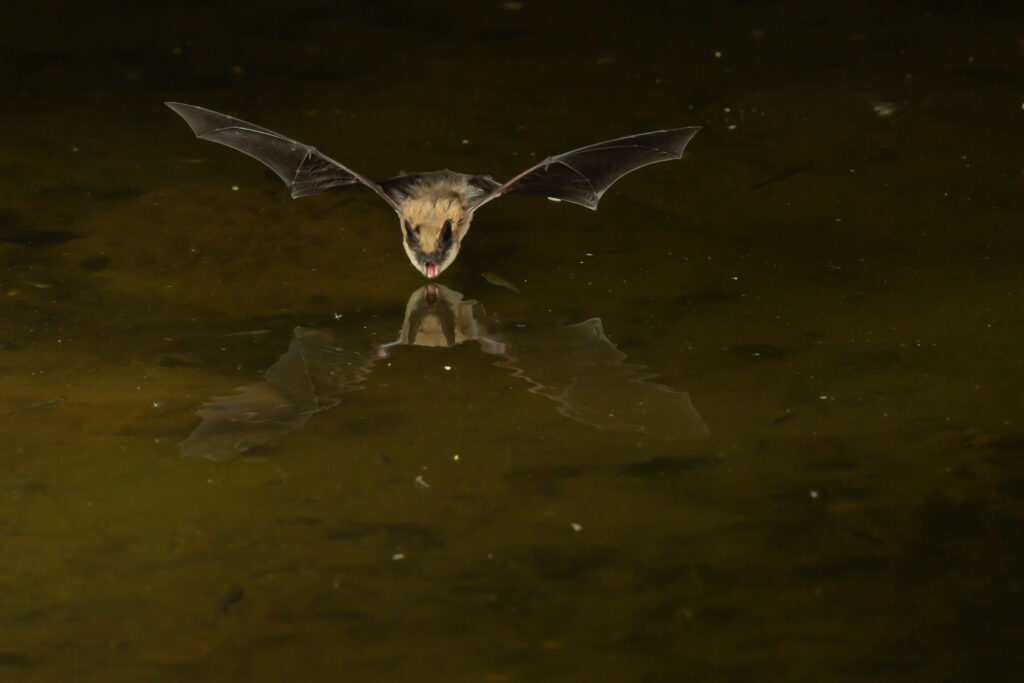A Case for Going to Bat for the Bats
Bats play a vital role in ecosystems. But new research shows that if action isn’t taken, the future of these essential winged mammals in North America may be in jeopardy.
Published October 31, 2024
By Nick Fetty
Digital Content Manager

More than half of North American bat species may face extinction in the next two decades, according to researchers from Canada, Mexico, and the United States.
Recent research, published 15 October 2024 in Annals of the New York Academy of Sciences (Annals) built upon findings from a 2023 report by the North American Bat Conservation Alliance. For the Annals paper, researchers assessed the status of 153 bat species. The paper identified several factors threatening these bats, ranging from climate change and energy production to agriculture and problematic species, particularly disease.
The Impact of These Threats
Bats are vital to ecosystems. They serve as pollinators and insect consumers, both of which help to advance agricultural production. Furthermore, sustainable guano harvesting and tourism around viewing bat behaviors, support some local economies.
Temperature fluctuations, exacerbated by climate change, are impacting hibernation behavior and foraging opportunities for bats. They also detrimentally impact the timing of insect availability—a source of subsistence for many bat species. Additionally, extreme weather events have contributed to bat die-offs.
While renewable energy can lessen the amount of carbon in the atmosphere, and mitigate the impact of climate change, gigantic wind turbines are proving to have harmful effects on bats. This is especially problematic in migratory regions where wind energy development has grown in recent years. According to the paper, turbines are responsible for hundreds of thousands of bat fatalities each year in North America.
While owls, hawks, and snakes are natural predators of bats, disease poses the greatest threat. White-nose syndrome (WNS), caused by the invasive fungus Pseudogymnoascus destructans (Pd), has been devastating for bat populations. First discovered in New York in 2007, WNS affects bats during hibernation and causes a “visible white fungal growth on infected bats’ muzzles and wings.”
Populations of the little brown bat (Myotis lucifugus), the Indiana bat (Myotis sodalis), and the northern long-eared bat (Myotis spetentronalis) have declined by more than 90% because of these contagious fungi. Arthuro Casadevall, MD, PhD, author of What if Fungi Win?, discussed this during his Authors at the Academy event in July (Dr. Casadevall was not among the authors of the Annals paper). He told attendees that “The losses in North American bats cannot be replaced very easily. It will probably take centuries.”
Mitigating the Threats
The international team of researchers for the Annals paper found that 53% of North American bat species are estimated to have moderate to very high risk of extinction or elimination in the next 15 years. An estimated 90% of species will see decreased or likely decreased populations during the same period. The researchers identified 18 bat species (12%) as “Imperiled” or “Critically Imperiled”.
While the threats to bat populations are increasingly clear, the paper’s authors provide various suggestions for how these issues can be mitigated. Governments in Canada, Mexico, and the United States have implemented federal protection status for the most vulnerable bat populations. Eight of the species identified as Imperiled or Critically Imperiled have protective status in all three countries.
Similarly, governments, and other sectors, can take action to mitigate the impacts of climate change, which, again, has been identified as one of the biggest threats against bats. By protecting, restoring, and creating wetlands and other water sources, it can lessen the biggest climate change threats facing bats. Adopting sustainable agricultural practices, such as utilizing native trees for shading, not only protects the bats, but can also help to conserve the productivity of the land.
To mitigate the threats caused by wind turbines, turbine operations can be curtailed at night during migratory periods. Further study of WNS can provide researchers with evidence to support the need for meaningful policy action. By lessening the knowledge gap in other applicable areas like ecology, distribution, and migratory behaviors, researchers can promptly act to mitigate some of the biggest threats facing bats.
Call to Action
Urgent action is necessary to ensure these threats don’t proliferate further decline in bat populations, according to the researchers. This includes better educating the public about the importance of bats to the overall environment and why people need to support legislation that can protect these creatures. When the pace of the research can’t keep up with the direness of the threat, governments can act in the form of federal endangered species declarations as a last line of defense. If properly executed, these actions can “yield far-reaching benefits for both biodiversity and humanity.”
“Research on bat biology can spark innovative ideas for effective conservation actions that reduce population decline, and these actions can bring complementary benefits to habitats that other taxa (species) also rely on,” the authors concluded. “With coordinated efforts to reduce threats, raise public awareness, protect and restore habitat, and monitor species status and trends, conservation efforts can improve the outlook for bat species across North America and globally.”
Do you have a research paper you’d like to submit for publication in Annals of the New York Academy of Sciences? Learn more about the journal’s criteria and submission process.
